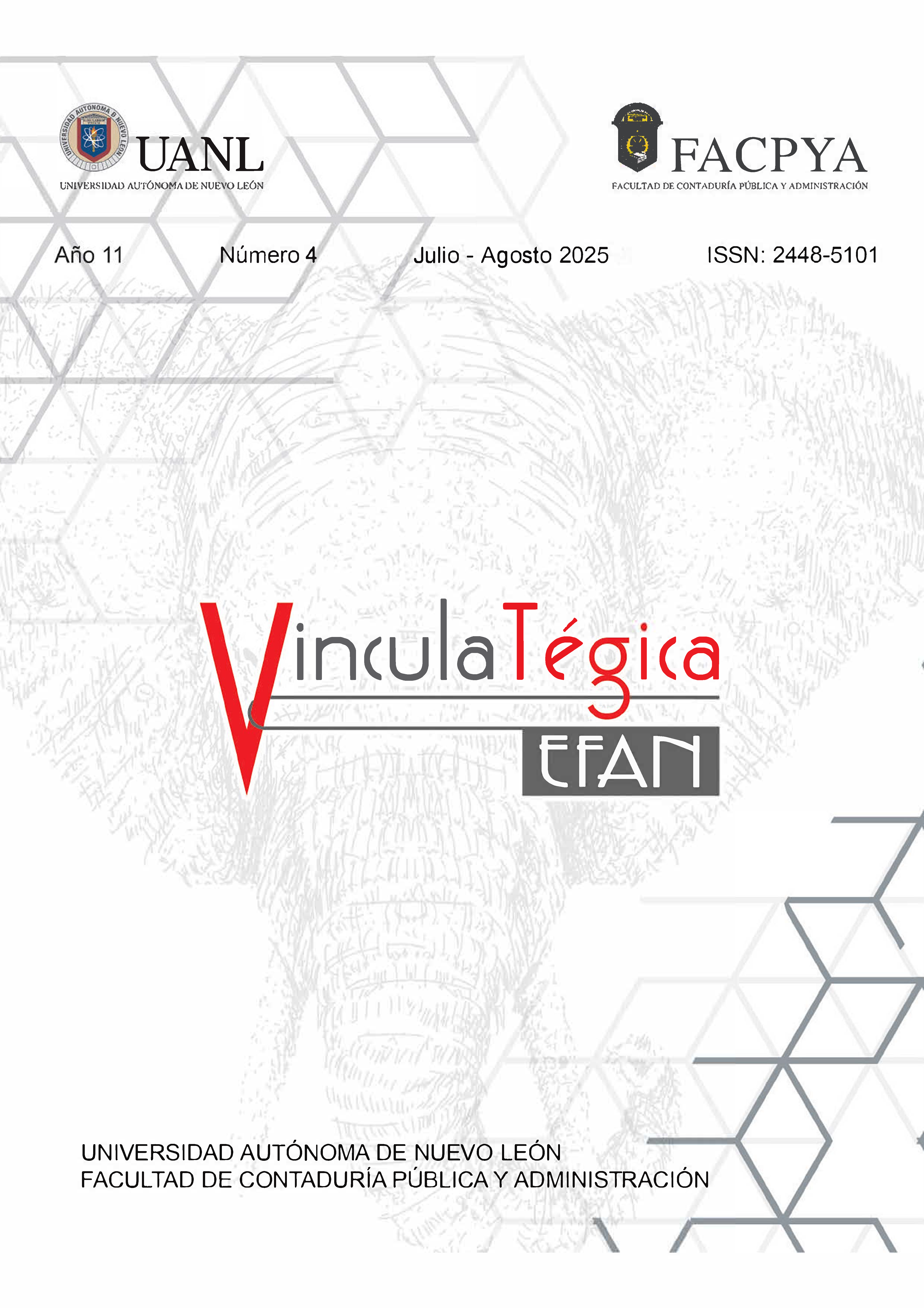Analysis of teacher support from the student's perception on the Blackboard platform: a case study
DOI:
https://doi.org/10.29105/vtga11.4-1148Keywords:
Educational platform, teacher accompaniment, student activitiesAbstract
Recent educational demands driven by technology seek to optimize the benefits of digitalization to enhance accessibility, personalization, collaboration and evaluation, emerging teaching 5.0, to create interactive, adaptive and student-centered educational experiences, developing skills required in the 21st century. This study analyzes the satisfaction of university students with the teaching accompaniment on the Blackboard platform. An information collection instrument was applied to 311 students aged 17 to 21 years distributed homogeneously by gender, from an institution in northern Mexico, the data were processed with SPSS 24 and SMART PLS. Quantitative method, descriptive design, cross-sectional design and a simple linear regression analysis were used. The results show that Pearson's correlation determination coefficient R² indicates that 74.5% of the teaching accompaniment is explained by the variability of the model, with a standardized coefficient β = 0.846 for the independent variable "Student Activities". The research hypothesis is accepted, with a critical value of T >1.96 and a P-Value <0.05, highlighting the importance of effective interaction in teacher accompaniment as a crucial factor for the success of online learning, its strengthening can significantly transform educational quality.
Downloads
References
Aliaga, C. y Dávila, O. (2021). La plataforma Blackboard: una herramienta para el proceso de enseñanza-aprendizaje. Hamut´ay, 8(1), 42-58. http://dx.doi.org/10.21503/hamu.v8i1.2237 DOI: https://doi.org/10.21503/hamu.v8i1.2237
Baque-Castro, G., Calderón-Chinga, G., Campuzano-López, J. & Barcía-Briones, M. (2021). El rol docente y el estrés de la modalidad virtual. Pol. Con. (Edición núm. 54) Vol. 6, No 2, Febrero 2021, pp. 1016-1026. https://doi.org/10.23857/PC.V6I2.2333
Bautista-Boada, F. (2021). Teoría del Procesamiento de la Información Mediada por la Blackboard para la Enseñanza del Inglés. Revista Tecnológica-Educativa Docentes 2.0, 1(1), 108-116. https://doi.org/10.37843/rted.v1i1.260 DOI: https://doi.org/10.37843/rted.v1i1.260
Berrones-Yaulem, L., Bautista-Samaniego, J., Tapia-Brito, D. & Moposita-Vásquez, D. (2023). Explorando el aprendizaje ubicuo: Características, desafíos y experiencias en la era digital. Dominio de las Ciencias, 9(3), pp. 1875-1895. https://doi.org/10.23857/dc.v9i3 DOI: https://doi.org/10.23857/dc.v9i3
Blackboard Inc. (2018). Guía de funciones de la aplicación Blackboard. https://help.blackboard.com/es-es/Blackboard_App/Feature_Guide
Gómez-García, M., Lagunes-Domínguez, A., Ortiz-Padilla, M.E. & Umaña-Mata, A.C. (2023). Tecnologías educativas y escenarios digitales. Tendencias en los posgrados universitarios. Revista Electrónica Interuniversitaria de Formación del Profesorado, 26(1), 55-69. https://doi.org/10.6018/reifop.545421 DOI: https://doi.org/10.6018/reifop.545421
Martínez-Garcés, J., & Garcés-Fuenmayor, J. (2020). Competencias digitales docentes y el reto de la educación virtual derivado de la covid-19. Educación y Humanismo, 22(39), 1-16. https://doi.org/10.17081/eduhum.22.39.4114 DOI: https://doi.org/10.17081/eduhum.22.39.4114
Meza, E. & Esponisa, F. (2023). Uso de Blackboard y aprendizaje efectivo en una institución de educación superior. Revista Cientifica YACHAQ. 6(2), https://doi.org/10.46363/yachaq.v6i2.3 DOI: https://doi.org/10.46363/yachaq.v6i2.3
Prado (2020). Enfoque axiológico en la Educación Superior mediante la interacción de los estudiantes en el Entorno Virtual de Aprendizaje. Revista e-Ciencias de la Información, 11(1), http://dx.doi.org/10.15517/eci.v11i1.41379 DOI: https://doi.org/10.15517/eci.v11i1.41379
Rizo. M. (2020). Rol del docente y estudiante en la educación virtual. Revista Multi-Ensayos, 6(12) https://doi.org/10.5377/multiensayos.v6i12.10117 DOI: https://doi.org/10.5377/multiensayos.v6i12.10117
Saborío-Taylor, S. (2024). Influencia Educativa en la Era Digital: Puntos Clave desde la Perspectiva de la Docencia 5.0. Revista Innovaciones Educativas, 26, https://doi.org/10.22458/ie.v26iespecial.5321 DOI: https://doi.org/10.22458/ie.v26iEspecial.5321
Serna, R. y Alvites-Huamaní, C. (2021). Plataformas Educativas: Herramientas digitales de mediación de aprendizajes en educación. Hamut´ay, 8 (3), pág. 66-74, http://dx.doi.org/10.21503/hamu.v8i3.2347 DOI: https://doi.org/10.21503/hamu.v8i3.2347
Vega, C., Sánchez, M. , Rosano, G, & Amador, S. (2021). Competencias docentes, una innovación en ambientes virtuales de aprendizaje en educación superior. Revista Apertura, 13(2), pp. 6-21. http://doi.org/10.32870/Ap.v13n2.2061 DOI: https://doi.org/10.32870/Ap.v13n2.2061
Vital, M. (2021). Plataformas Educativas y herramientas digitales para el aprendizaje. Vida Científica: Boletín Científico de la Escuela Preparatoria No. 4, 9(18) pp. 9-12. https://repository.uaeh.edu.mx/revistas/index.php/prepa4/issue/archive
Zempoalteca, B., Martínez, J. & Guzmán, T. (2023). Competencia digital docente para la mediación en ambientes virtuales mixtos. Revista Apertura. 15(1). Universidad de Guadalajara. Pp.102 - 121. http://doi.org/10.32870/Ap.v15n1.2276 DOI: https://doi.org/10.32870/Ap.v15n1.2276
Downloads
Published
How to Cite
Issue
Section
License
Copyright (c) 2025 Victor Manuel Cárdenas-González, Alicia Celina-Leal, Gabriela Soledad Ulloa-Duque

This work is licensed under a Creative Commons Attribution 4.0 International License.
a). Authors keep copyright and give the journal the right of the first publication of the work under a Creative Commons attribution license. This license allows others to share the work as long as original authorship and initial publication in this journal is acknowledged.
b). Authors may make other independent and additional contractual agreements for the non-exclusive distribution of the version of the article published in this journal (e.g., include it in an institutional repository or publish it in a book) as long as they clearly indicate that the work was published for the first time in this journal.







